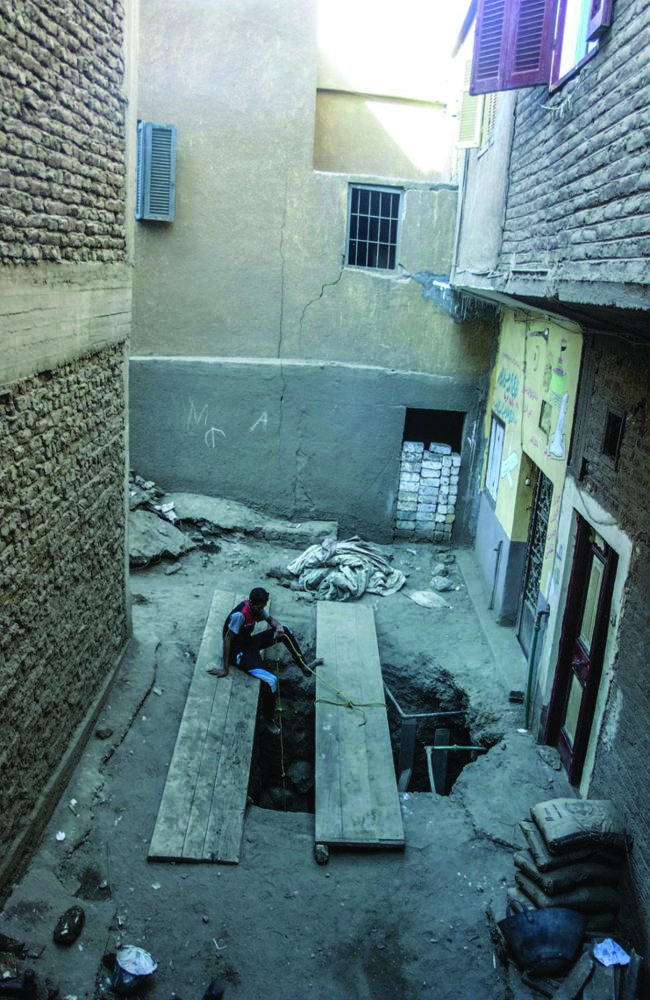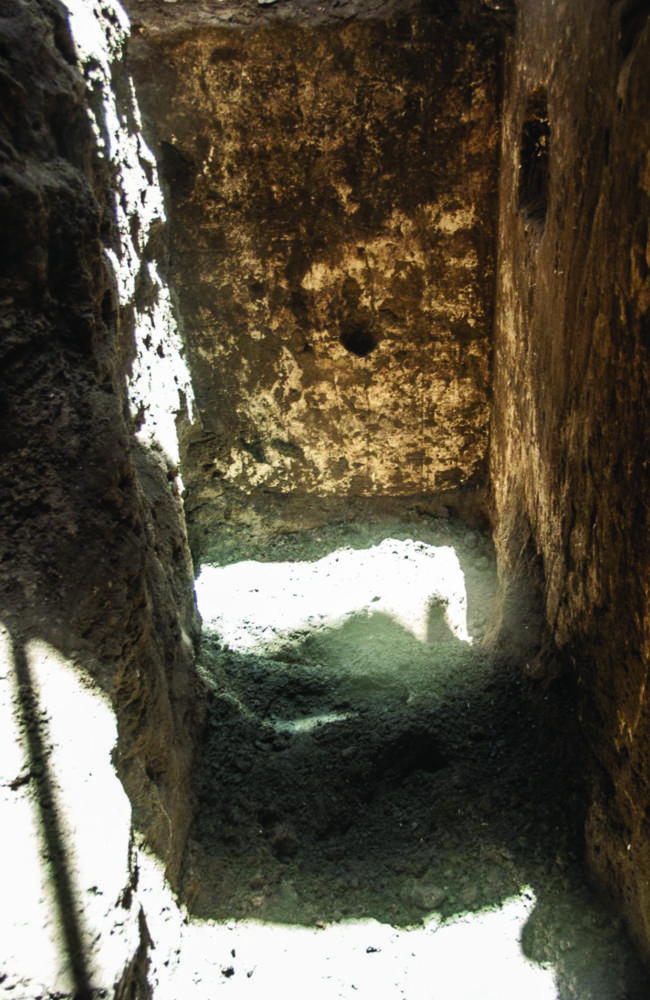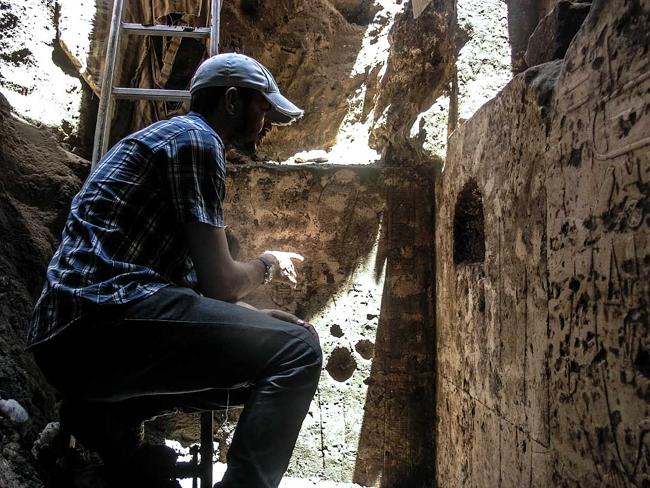It looks like you're using an Ad Blocker.
Please white-list or disable AboveTopSecret.com in your ad-blocking tool.
Thank you.
Some features of ATS will be disabled while you continue to use an ad-blocker.
39
share:
An ancient chapel dedicated to Pharaoh Mentuhotep II has been found by city municipality workers under the streets of Abydos. The site was only found
due to a sinkhole, which appeared to have been caused by the digging of a hole by looters inside a a neighbouring house.
After the discovery of the chapel, authorities were called, and the looters were arrested. Archeologists are now examining the site, but are restricted from excavating further, due the the location being under city streets.
Some photos:




Source:
goo.gl...
- Daas.
After the discovery of the chapel, authorities were called, and the looters were arrested. Archeologists are now examining the site, but are restricted from excavating further, due the the location being under city streets.
Some photos:




Source:
goo.gl...
- Daas.
a reply to: daaskapital
Wow! Thank heavens no-one actually fell in and got hurt. What a discovery I wonder if they will find something unknown to us before.
I wonder how the people who live in the area feel about looters rummaging under their houses? Bit frightening, although the street itself looks so ancient to me. It highlights the different conditions of living in an ancient city to living in a modern eco village.
Wow! Thank heavens no-one actually fell in and got hurt. What a discovery I wonder if they will find something unknown to us before.
I wonder how the people who live in the area feel about looters rummaging under their houses? Bit frightening, although the street itself looks so ancient to me. It highlights the different conditions of living in an ancient city to living in a modern eco village.
a reply to: daaskapital
en.m.wikipedia.org...
Here is a bit of info on the mentuhotep II .
Thanks for the thread !
S+F
Nebhepetre Mentuhotep II (reigned ca. 2046 BC – 1995 BC) was a Pharaoh of the 11th dynasty who reigned for 51 years. Around his 39th year on the throne he reunited Egypt thus ending the First Intermediary Period. Consequently, he is considered the first pharaoh of the Middle Kingdom.
en.m.wikipedia.org...
Here is a bit of info on the mentuhotep II .
Thanks for the thread !
S+F
a reply to: Shiloh7
In any settlement of significant age, there are layers upon layers. London, for example, has layer after layer, like a massive dirty onion. People know that there are tunnels for the tube to run through, but what many people do not realise, when staring at the dome of St Paul's cathedral, or eyeballing the London Eye, is that there are layers of archeology going back to the Roman occupation period, even entire Roman streets, beneath the paving slabs.
Rail workers there are prone to discovering all manner of interesting archeology when about the course of their duties, digging new underground connections, and during the construction of new stations.
Of course, Egyptian methods of burial and building from the period with which this discovery in Abydos is concerned, mean that its archeology is much easier to draw conclusions from, than the archeology of many other world wide locations. However, easy to decipher or not, every significant settlement which has existed for a long period of time, gains these layers.
Fascinating stuff!
@OP
Star and flag and all that!
In any settlement of significant age, there are layers upon layers. London, for example, has layer after layer, like a massive dirty onion. People know that there are tunnels for the tube to run through, but what many people do not realise, when staring at the dome of St Paul's cathedral, or eyeballing the London Eye, is that there are layers of archeology going back to the Roman occupation period, even entire Roman streets, beneath the paving slabs.
Rail workers there are prone to discovering all manner of interesting archeology when about the course of their duties, digging new underground connections, and during the construction of new stations.
Of course, Egyptian methods of burial and building from the period with which this discovery in Abydos is concerned, mean that its archeology is much easier to draw conclusions from, than the archeology of many other world wide locations. However, easy to decipher or not, every significant settlement which has existed for a long period of time, gains these layers.
Fascinating stuff!
@OP
Star and flag and all that!
I wish something sudden and unavoidable like this would happen and reveal something tptb don't want us to see.
This is actually the last great unlooted part of Egypts history - the parts of 'lost' ancient cities that are buried underneath currently inhabited
settlements.
There are a lot of very exciting sites that have never been excavated, where we suspect there are some pretty amazing things waiting to be found.
I sort of hope this doesn't give the looters ideas, because tragically so much has now been lost in Egypt since the revolution triggered the wholesale destruction of so many important archaeological sites.
There are a lot of very exciting sites that have never been excavated, where we suspect there are some pretty amazing things waiting to be found.
I sort of hope this doesn't give the looters ideas, because tragically so much has now been lost in Egypt since the revolution triggered the wholesale destruction of so many important archaeological sites.
It is absolutely amazing all the stuff that must be buried in Egypt. We clearly have not even scratched the surface with Giza.
a reply to: daaskapital
What else is under this city!
I find it sad when they find all that ancient writing I never end up hearing it translated, it seems to just disappear in the great well of non information out there.
What else is under this city!
I find it sad when they find all that ancient writing I never end up hearing it translated, it seems to just disappear in the great well of non information out there.
a reply to: TrueBrit
That's true, the UK has fascinating archaeology right under our streets, fields, buildings and pavements.
I am rather passionate about history though sometimes I am surprised about how blasé many are to the fabulousness of it all.
One of my favourites is in Bath, the ancient Roman settlement of Aquae Sulis, is the Temple dedicated to the combination goddess Sulis Minerva
That's true, the UK has fascinating archaeology right under our streets, fields, buildings and pavements.
I am rather passionate about history though sometimes I am surprised about how blasé many are to the fabulousness of it all.
One of my favourites is in Bath, the ancient Roman settlement of Aquae Sulis, is the Temple dedicated to the combination goddess Sulis Minerva
edit on 8-7-2014 by theabsolutetruth because: (no reason given)
In cities like London and Paris, the construction materials for new buildings was obtained by carving holes into the limestone and sandstone bedrock.
As they were building homes upwards, they were negatively constructing basement space downwards (removing material, not piling it up). We can only
imagine they did the same around Egypt.
With London, not only are there underground Tube lines, but there are also underground vaults and archives. The locations of which are still considered secret, so when the route of a new tube line has been proposed, the contractors would have to draw up plans and submit them for approval. This would lead to a guessing game where they wouldn't be told of the places to avoid, but just whether the route was acceptable or not.
With London, not only are there underground Tube lines, but there are also underground vaults and archives. The locations of which are still considered secret, so when the route of a new tube line has been proposed, the contractors would have to draw up plans and submit them for approval. This would lead to a guessing game where they wouldn't be told of the places to avoid, but just whether the route was acceptable or not.
Even the pyramids of Giza were built on older monuments.
It poses quite a dilemma for archeology because to explore the older site you must disturb the current site.
Some of the cities in the Indus Valley were rebuilt 5 or 6 times.
Interesting that the older sites are the best constructed.
It poses quite a dilemma for archeology because to explore the older site you must disturb the current site.
Some of the cities in the Indus Valley were rebuilt 5 or 6 times.
Interesting that the older sites are the best constructed.
originally posted by: Hmmmmmmm
Even the pyramids of Giza were built on older monuments.
While it is possible that one or more of the pyramids were built over an existing shrine there is no definitive proof, just speculation.
Some of the cities in the Indus Valley were rebuilt 5 or 6 times.
That might be misleading; Harappan cities were made mainly of unfired mud brick which dissolves in rain causing the cities to be constantly rebuilt, resulting in the development of mounds. Not sure where you got '5 or 6', the correct term would be 'continuously' and that for seven hundred or so years.
Interesting that the older sites are the best constructed.
Nope, that is a commonly stated idea but there is no evidence for it and a great deal against it
originally posted by: Shiloh7
a reply to: daaskapital
I wonder how the people who live in the area feel about looters rummaging under their houses?
In all likelihood, the people that lived in the house are the looters.
Harte
edit on 7/9/2014 by Harte because: (no reason given)
new topics
-
whistleblower Captain Bill Uhouse on the Kingman UFO recovery
Aliens and UFOs: 3 hours ago -
1980s Arcade
General Chit Chat: 6 hours ago -
Deadpool and Wolverine
Movies: 6 hours ago -
Teenager makes chess history becoming the youngest challenger for the world championship crown
Other Current Events: 7 hours ago -
CIA botched its handling of sexual assault allegations, House intel report says
Breaking Alternative News: 8 hours ago -
Lawsuit Seeks to ‘Ban the Jab’ in Florida
Diseases and Pandemics: 11 hours ago
top topics
-
Lawsuit Seeks to ‘Ban the Jab’ in Florida
Diseases and Pandemics: 11 hours ago, 20 flags -
Starburst galaxy M82 - Webb Vs Hubble
Space Exploration: 13 hours ago, 12 flags -
The Superstition of Full Moons Filling Hospitals Turns Out To Be True!
Medical Issues & Conspiracies: 14 hours ago, 8 flags -
CIA botched its handling of sexual assault allegations, House intel report says
Breaking Alternative News: 8 hours ago, 8 flags -
whistleblower Captain Bill Uhouse on the Kingman UFO recovery
Aliens and UFOs: 3 hours ago, 6 flags -
15 Unhealthiest Sodas On The Market
Health & Wellness: 13 hours ago, 5 flags -
Teenager makes chess history becoming the youngest challenger for the world championship crown
Other Current Events: 7 hours ago, 3 flags -
Deadpool and Wolverine
Movies: 6 hours ago, 3 flags -
1980s Arcade
General Chit Chat: 6 hours ago, 3 flags
active topics
-
Fast Moving Disc Shaped UFO Captured on Camera During Flight from Florida to New York City
Aliens and UFOs • 18 • : inflaymes69 -
Definitive 9.11 Pentagon EVIDENCE.
9/11 Conspiracies • 419 • : SchrodingersRat -
They Killed Dr. Who for Good
Rant • 61 • : Cymru -
How ageing is" immune deficiency"
Medical Issues & Conspiracies • 26 • : RookQueen2 -
The Democrats Take Control the House - Look what happened while you were sleeping
US Political Madness • 105 • : SchrodingersRat -
Starburst galaxy M82 - Webb Vs Hubble
Space Exploration • 4 • : SchrodingersRat -
Non-Human Operate Within The Visual Spectrum 'We Cannot See' - ULTRATERRESTRIALS EXIST!
Paranormal Studies • 136 • : burritocat -
New whistleblower Jason Sands speaks on Twitter Spaces last night.
Aliens and UFOs • 39 • : RookQueen2 -
23,000 Dead People Registered Within a Two Week Period In One State
US Political Madness • 39 • : Audreagassulke -
1980s Arcade
General Chit Chat • 7 • : Freeborn
39
